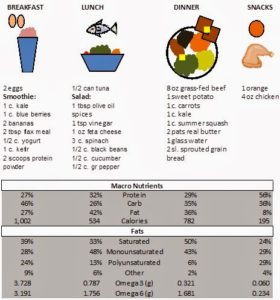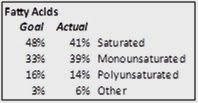By Peter Wright, NTP
This post is part of a six part series on fat. Please be sure to check out the other posts in this series. Click to return to Part 1 with links to the other posts in the series.
Part 2: Heart Disease is NOT the Result of Fat Consumption
Part 3: What are SFA, MUFA, PUFA, and Omega 3 & 6 Fats?
Part 4: How to Avoid Unhealthy BAD Fats
Part 5: How to Balance Your Fat Intake for Optimum Health
Part 6: The Buyer’s Guide for Fat including Cooking Safely with Fats
When balancing your fat intake it’s important to remember there is no one perfect diet for everyone. Our bodies are biologically unique. Think of these recommendations as a starting point and realize you may have to make adjustments based on your body’s individual response. That being said, for the vast majority of the population who are currently eating the standard American diet (SAD) these recommendations will lead to dramatically improved health.
 |
| Balancing Fats |
Let’s start with the proper ratio of total fat in relation to protein and carbohydrates. Fat should represent 30 percent of your daily caloric intake. Protein should represent 30% and the remaining 40% should be high quality carbohydrates. Fat contains 9 calories per gram versus protein and carbohydrates which contain 4 calories per gram. This means by volume the portion size of fats will be smaller in comparison to protein and carbohydrates. As your diet evolves and becomes based on whole foods, I advocate reducing the carbohydrate category to 30% of your daily calories while increasing fat to 40%.
I don’t advocate counting calories; it’s far more important to think of food in terms of its nutrient content. You should be able to look at your meal and identify the fat, protein, and carbohydrate foods. Periodically it is very useful to keep a food journal and do an analysis of the macro nutrient ratios you’re consuming. We all tend to fall into habitual eating patterns and the food journal can be very enlightening. You’ll gain great insight into your eating patterns, allowing you to modify your diet to optimize health.
The illustration below depicts a whole foods daily diet following the 30% protein, 40% carbohydrate, and 30% fat recommendation. It assumes beverages of water or herbal teas which don’t affect the macro nutrient ratios. If you’re currently eating the standard American diet (SAD), this representation of meals may look strange to you. You may notice the absence of typical American choices; breakfast cereal, fast food, pizza, pasta, frozen meals, soda, fries, etc. Those typical choices are all far too high in carbs and poor quality fats.
 |
| Balanced Macro Nutrient Diet |
To determine the total calories I used an on-line calorie calculator http://www.freedieting.com/tools/calorie_calculator.htm. Entering your age, height, weight, and activity level the calculator determines daily calories to maintain the bodyweight entered. I chose a 49 year old male, 195lbs, and 6’4” tall and arrived at a maintenance level of around 2500 calories.
To determine the breakdown of saturated, monounsaturated, polyunsaturated, omega-6, and omega-3 fats I used the data provided at http://nutritiondata.self.com. If you try to do this yourself, one thing you’ll notice is the total fat grams for a food don’t equal the sum of the saturated plus monounsaturated plus polyunsaturated. This is because there are other fatty substances included in the total which are not considered part any of the three fatty acid groups, for example phospholipids, glycerol and sterols. The best-known sterol is cholesterol.
The sample meal plan meets our macro nutrient ratios very well at 31% protein, 38% carbs, and 31% fat. Not every meal, or even every day, will perfectly meet the target. That’s fine. The objective is to meet the ratios “on average”. While it’s better for your health to eat balanced meals and snacks, if you eat a meal you know is too high on the carb side, just adjust the following meals to bring the day into balance. Over time it all becomes quite natural and you’ll notice you feel better, both mentally and physically, when your meals and snacks have a healthy macro nutrient balance.
 Now that we have an idea of how to achieve the proper percentage of total fat in our daily diet we need to look at balancing the type of fats in our daily allowance. Remember, saturated, monounsaturated, and polyunsaturated fats perform different functions in your body so they are required in different quantities. To determine the proper ratio we look to nature’s perfect human food; breast milk. “Human breast milk is 48% saturated, 33% monounsaturated, and 16% polyunsaturated. Human breast milk is the best and only suitable food for a human baby. Since our physiology does not change as we grow, our requirements for a particular fat stays about the same.”1
Now that we have an idea of how to achieve the proper percentage of total fat in our daily diet we need to look at balancing the type of fats in our daily allowance. Remember, saturated, monounsaturated, and polyunsaturated fats perform different functions in your body so they are required in different quantities. To determine the proper ratio we look to nature’s perfect human food; breast milk. “Human breast milk is 48% saturated, 33% monounsaturated, and 16% polyunsaturated. Human breast milk is the best and only suitable food for a human baby. Since our physiology does not change as we grow, our requirements for a particular fat stays about the same.”1  Our sample daily diet lines-up well with the optimum levels of saturated, monounsaturated, and polyunsaturated fats. It’s extremely important to recognize the quality of the food eaten is critical to achieving these ratios of fatty acids. The absence of commercial vegetable oils and processed foods keeps polyunsaturated fat in the proper relationship to the other fat categories. Using real butter rather than margarine or butter substitutes also reduces the polyunsaturates.
Our sample daily diet lines-up well with the optimum levels of saturated, monounsaturated, and polyunsaturated fats. It’s extremely important to recognize the quality of the food eaten is critical to achieving these ratios of fatty acids. The absence of commercial vegetable oils and processed foods keeps polyunsaturated fat in the proper relationship to the other fat categories. Using real butter rather than margarine or butter substitutes also reduces the polyunsaturates. Another important fat ratio for optimum health is the ration of omega-6 polyunsaturates to omega-3 polyunsaturates. The importance of keeping these fats in balance was explained in Part 3 of this series, “What are SFA, MUFA, PUFA, and Omega 3 & 6 Fats?”. Once again, achieving the proper ratio is dependent on the quality of the food eaten. Eggs from free-range chickens and beef from grass-fed animals have a very different fat content from the conventionally grown alternatives. Meat from grass-fed animals has two to four times more omega-3 fatty acids than meat from grain- fed animals. Free range eggs have twice the omega-3 as conventionally raised eggs from caged chickens. Our sample diet does a good job of meeting the optimum ratio. Inclusion of fish and flax seed, both high in omega-3 were important in meeting the goal. The easiest way to meet the optimal 1.4 to 1 ratio is to avoid ALL processed foods, which are extremely high in denatured, damaged omega-3 fats and omega-6 fats.
Many people get the idea that if omega-3’s are good then the more the better. This is not true. It is the proper balance that is important. “People need to take in at least 2-3% of their calories as fat in the form of omega-6 fatty acids and at least 1-1.5 percent of their calories as fat in the form of omega-3 fatty acids.”2 Our sample diet provided 1.8% of calories from omega-3 and 2.5% of calories from omega-6 fatty acids. Once again the sample diet falls within the recommendations for optimum health. Note the high omega-3 foods consisted of just 2 tablespoons of flaxseed meal and a half can of tuna.
In the final post in the series, Part 6: The Buyer’s Guide for Fat including Cooking Safely with Fats, I’ll give you the knowledge you need to safely purchase the healthiest fats and explain how to cook with them without damaging their health giving properties.
1 Dr. Natasha Campbell-McBride MD, Gut and Psychology Syndrome, 2010
2 Mary G. Enig, Ph.D., Director Nutritional Sciences Division Enig Associates, Inc., http://articles.mercola.com/sites/articles/archive/2000/01/16/dangers-canola-oil.aspx
Photo 1 – Image courtesy Kittisak- FreeDigitalPhotos.net
Latest posts by Peter Wright, NTP, CGP (see all)
- Dehydrated Broth – Making It Easy to Drink Broth Every Day! - March 11, 2017
- Lose 10 lbs DURING the Holidays - November 19, 2016
- Finding Good Oils - February 7, 2016



No comments yet.